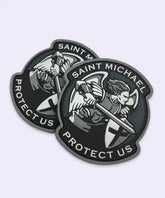Self-Adhesive Patches For Clothes: Use, Types, and Application
Table of Contents
- Self-Adhesive Patches For Clothes: Use, Types, and Application
- Attaching a Self-adhesive Patch to Clothes Without Sewing
- These steps include:
- Temporary attachment of an Adhesive Patch to clothing?
- Main Difference Between Iron-on Patches and Self Adhesive Patches for Clothes
- 2. Types of self-adhesive patches
- Self-adhesive letter patches
- Self-adhesive fabric repair patches
- Self-adhesive decorative patches
- Self-adhesive embroidered patches
- Self-adhesive PVC or rubber patches
- Self-adhesive reflective or safety patches
- Self-adhesive badge or logo patches
- 3. Durability
- Do self-adhesive fabric patches come off?
- How long do self-adhesive clothing patches last?
- Is it possible to iron on adhesive patches?
- CONCLUSION
- FAQs
- Q1) How to attach a patch to clothes without sewing?
- Q2) Do adhesive patches come off?
- Q3) How to temporarily attach a patch to clothing?
- Q4) How long do adhesive patches last?

Self-Adhesive Patches For Clothes: Use, Types, and Application
Self-adhesive patches for clothes are decorative and ready to use whenever you want. These are mostly made from Nylon or woven fabric and have a sticky backing, which helps them to stick to clothes easily. You can attach them to your clothes and accessories, such as bags, caps, and more. Using these patches is very convenient as you just need to take them out of their packaging, peel them, and simply apply them to your clothes wherever you want. They don't require any sewing or heat application.
Simply press the patch onto the desired area after removing the protective layer. These can be both temporary and semi-permanent; their durability depends merely on how strong the adhesive backing is. Their application is straightforward, and they can be used for many different purposes.
Attaching a Self-adhesive Patch to Clothes Without Sewing
To attach self-adhesive patches to clothes, there are specific steps that need to be followed
These steps include:
- Make sure the fabric's surface is clean and dry.
- Remove the patch from its packaging and peel off the protective paper.
- Press the patch on your clothes where you want it and press for 50 to 60 seconds to make sure it sticks properly
- This is an unnecessary step, but placing a cloth over the patch and ironing it might make it stick better.
These patches are specially designed so that sewing and ironing are not required.
Temporary attachment of an Adhesive Patch to clothing?
Sometimes you want to temporarily customize your clothes or reuse the patch somewhere else. In this case, you will have to opt for patches that have a weak adhesive backing. They typically last 4 to 5 uses before losing their stickiness. An alternative to this is fabric-safe glues, which come in types that allow repositioning. This will enable you to reuse patches and use them temporarily as needed.
Main Difference Between Iron-on Patches and Self Adhesive Patches for Clothes
The main difference between an iron on patch and a self-adhesive patch is that self-adhesive patches have peel and stick sticker backing, which means that you need to peel off the protective backing and directly stick it onto any cloth you want, this patch is temporary as it loses its adhesive strength with time but it's the easiest patch to apply as it just needs peeling and sticking. However, iron-on patches have a heat-activated glue on the back, which means that they cannot be used without ironing them onto the cloth. This patch becomes permanent after cooling. It is essential to carefully align this patch because once it's ironed on, it becomes permanent.

2. Types of self-adhesive patches
Self-adhesive letter patches

Self-adhesive letter patches are shaped like the alphabet. They can have different textures, like embroidered or chenille. They are popular in sports jerseys and varsity jackets and can also be used in personalizing clothes, bags, hats, and more.
Self-adhesive fabric repair patches

Self-adhesive fabric repair patches are used to cover areas of clothes that have holes or are ripped. They are patterned or plain fabric patches. They are mostly made of materials such as Nylon, canvas, denim, or polyester.

Self-adhesive decorative patches
These patches are fun and decorative, coming in many designs that attract people's attention.
Self-adhesive fabric patches are used in themed outfits and kids' clothing, as well as for fashion. The materials used in these are mostly felt, embroidered, or PVC.
Self-adhesive embroidered patches
These have high-quality thread embroidery on a fabric base with a sticky backing and are used in branding, logos, uniforms, and more, and are popular amongst clubs and fashion brands.
Self-adhesive PVC or rubber patches
They are durable, waterproof, and weather-resistant, featuring 3D designs that make them attractive. They are primarily used for outdoor gear, such as backpacks and military items.
Self-adhesive reflective or safety patches
These patches are visible in low light as they are reflective. They are usually used in safety jackets, kids' bags, cycling gear, and more.
Self-adhesive badge or logo patches
These can be for custom logos, brand badges, and more. They have a sticky backing and can be used in events, temporary uniforms, and promotional items.

3. Durability
Do self-adhesive fabric patches come off?
Yes, self-adhesive clothing patches can come off if used frequently and roughly; they are not as permanent as sew-on patches. These are good for short-term uses because the adhesive strength decreases over time, causing the patch to come off. They are primarily used for decorative purposes, intended for a shorter period.
How long do self-adhesive clothing patches last?
Self-adhesive patches can be of two types: temporary and semi-permanent. The temporary ones can be easily removed as they are not that sticky. Semi-permanent ones also come off, but take longer than the temporary ones; these patches lose their adhesive strength with time. These stick-on patches can last up to 6 to 12 months, depending on the type of fabric and how frequently it's used and washed. These patches are not recommended for fabrics that are stretchy or delicate. The adhesive backing does not adhere well to fabrics like silk, Nylon, or velvet. These materials can easily come off if washed frequently, making it a temporary solution. It's temporary and will last only for a short time.
Is it possible to iron on adhesive patches?
The ability to iron on self-adhesive patches depends on the type of patch. If the patch is both iron-on and self-adhesive, you may use heat to reinforce the bond, this mostly work on patches that are made out of materials like cotton or denim, however, you cannot iron-on self-adhesive patches that are heat sensitive as heat can melt or warp so don't use iron, on patches that are made of materials that can melt. There is another way of ironing on self-adhesive patches, some patches loose its adhesive strength while heated so this method is not suggested for those, but the ones whose adhesive strength increases if heat is applied. Still, they cannot be heated in fear of being melted, can be ironed-on using indirect heat on it, like placing the patch where you want it to be applied then placing a cloth over it and ironing it on low heat without moving the iron, this helps increasing a patches adhesive strength.

CONCLUSION
Self-adhesive fabric patches offer a fun way to decorate your clothes without the hassle of sewing. They might be temporary, but they can serve a good purpose, as they can be removed after a while, and you can use other designs there. These patches come in many types, allowing you to choose the ones that suit your liking. Using fabric-safe glues, you can even reuse these patches, as these glues offer repositioning.
To keep these patches lasting longer, you must handle them gently. Rough handling can weaken and shorten their lifespan. However, taking care can keep them intact for a more extended period than if they are handled carelessly.
FAQs
Q1) How to attach a patch to clothes without sewing?
A) Clean the fabric, peel off the backing, and press firmly (optionally, iron lightly over a cloth).
Q2) Do adhesive patches come off?
A)Yes, the adhesive backing of the patches weakens in terms of strength after several uses or washes.
Q3) How to temporarily attach a patch to clothing?
A) Use light adhesive patches or fabric glue that allows repositioning, or use a weaker stick-on.
Q4) How long do adhesive patches last?
Usually 6 to 12 months, depending on quality, usage, and care.
- Do adhesive patches come off?
- How long do adhesive patches last?
- How to attach a patch to clothes without sewing?
- How to temporarily attach a patch to clothing?
- self adhesive clothing patches
- self adhesive fabric patches
- self adhesive letter patches
- self adhesive patches
- self adhesive patches for clothes
- self-adhesive fabric repair patches







